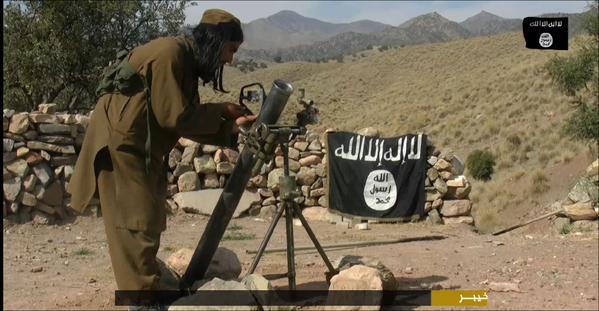
Islamic State in Afghanistan Ready to Capitalize on Mullah Omar’s Death
Publication: Terrorism Monitor Volume: 13 Issue: 18
By:

Afghanistan’s Taliban, in July 2015, confirmed the death of their leader, the amir al-mumineen (Commander of the Faithful), Mullah Muhammad Omar. Refuting allegations that Mullah Omar had lived in Pakistan, Taliban spokesperson Zabihullah Mujahid said that Omar “did not leave Afghanistan since the U.S.-backed forces overthrew the group in 2001, despite the Afghan assertion he died in a hospital in Pakistan” (VOA, July 30). Afghanistan’s National Directorate of Security (NDS) had earlier claimed that Mullah Omar expired in a Karachi hospital in 2013. In a late August statement, however, the Taliban admitted that Omar had indeed died in April 2013 (al-Arabiya, August 31).
One important effect of the Taliban’s confirmation of Mullah Omar’s death is that it may allow the Islamic State militant group to expand in Afghanistan, an area which the latter organization refers to as part of Wilayat Khurasan, which covers Pakistan, Afghanistan, Iran and Central Asian republics. This expansion is in line with the group’s strategic vision of global expansion. For instance, after strengthening its control over territories in Iraq and Syria, the Islamic State’s global leader and self-declared caliph, Abu Bakr al-Baghdadi said:
There are already visible Islamic State footprints in Afghanistan and Pakistan, and the group has already penetrated into the jihadist circles there. The group, in November, also announced Abdul Rahim Muslim Dost as its interim amir for the Khurasan region (Dawn, November 14, 2014). Dost, an Afghan national, was a former detainee at the U.S. Guantanamo Bay detention facility (Xinhua, September 30, 2006). Following his release, he rejoined the Afghan Taliban, but later pledged allegiance to al-Baghdadi after the Islamic State became prominent in Iraq in 2014. Despite this promising jihadist CV, in an unusual step, the Islamic State’s high command soon replaced Dost with Hafiz Saeed Khan, a Pakistani commander of the Tehrik-e-Taliban Pakistan-Fazlullah (TTP-F) jihadist group who had defected to the Islamic State in September 2014 (Economic Times, January 28). Saeed Khan had previously commanded TTP-F’s Orakzai chapter in Pakistan, where he hailed. He was soon however killed in a U.S. drone strike in Afghanistan in mid-2015, disrupting the Islamic State’s plans for him (Dawn, July 12).
The advent of the Islamic State in Afghanistan is also likely to affect al-Qaeda’s operations in the region. Al-Qaeda leader Ayman al-Zawahiri disowned the other organization in 2013, a decision that effectively split the global jihadist movement. The two groups are now locked in a battle for supremacy and are competing to win the loyalties of jihadists worldwide. Since the Islamic State’s capture of Mosul from the Iraqi state in 2014 and its subsequent proclamation of the creation of an Islamic State in the group’s territories in Syria and Iraq, a plethora of former al-Qaeda affiliates have pledged allegiance to al-Baghdadi. This has also happened in Afghanistan, where some former al-Qaeda-linked jihadist groups have also pledged allegiance to Baghdadi, including Tehrik-e-Khilafat Pakistan, the Shahidullah Shahid Group of TTP and Jundullah (The News, October 6, 2014).
In Afghanistan, a small group of al-Qaeda militants who had pledged allegiance to veteran Afghan mujahideen leader Gulbuddin Hekmatyar, of the Hizb-e-Islami militant group, also joined hands with the Islamic State in Afghanistan. Hizb-e-Islami, however, denied claims that Hekmatyar himself had joined the Islamic State in Afghanistan (Express Tribune, July 13).
Another reason why the Taliban’s announcement of the death of Mullah Omar may also accelerate the expansion of the Islamic State among the region’s jihadist groups is that Omar was the only jihadist amir who could challenge al-Baghdadi’s credentials as “caliph” of the “Islamic State,” given that Omar had already made himself amir al-mumineen of the “Islamic Emirate” of Afghanistan. By contrast, al-Zawahiri had never claimed such titles for himself, and he had also renewed his pledge of allegiance to Mullah Omar after the death of Osama bin Laden in 2011 (Bin Laden had himself pledged allegiance to Mullah Omar in 1999). The pledging of al-Qaeda’s present and former amirs technically made al-Qaeda subsidiaries of the Afghan Taliban movement (the bayah is technically from leader to leader, not from organization to organization). [2] In response, al-Qaeda is trying hard to protect its leaders and affiliates from defecting to the Islamic State. An additional recent al-Qaeda move to reinvigorate its jihadist activities and to try to regain the initiative from the Islamic State was its announcement of the creation of al-Qaeda in the Indian Subcontinent (AQIS) in September 2014.
In addition, the Afghan Taliban movement appears likely to lose followers to the Islamic State after the death of Mullah Omar, who enjoyed a demigod-like status among his followers. The Islamic State, for its part, would certainly like to intrude into the areas traditionally known to have a strong Taliban following in Afghanistan, and particularly to take advantage of Mullah Omar’s death. Underlining this determination, in August, the Islamic State’s media wing released a video showing 10 Taliban fighters captured by the group being forced to kneel on landmines, which then blew them to pieces (al-Arabiya, August 12). This graphically demonstrated that the Islamic State is fully ready to openly take on the Afghan Taliban and is in no mood to compromise. Similarly, in June 2015, fierce clashes between Taliban and Islamic State fighters in Afghanistan’s Nangarhar Province resulted in deaths of 80 fighters from both sides. In response, the Taliban warned the Islamic State to stay out of Afghanistan (Express Tribune, June 20).
The Islamic State’s announcement of the creation of an Islamic state and its appointment of al-Baghdadi as caliph, which effectively demands the obedience of all other jihadist groups, showcases the group’s unaccommodating attitudes towards all other jihadist organizations, including in Afghanistan. A major issue is competition for religious-political leadership. The Islamic State appears to view the Afghan Taliban as a rival to their “Islamic state,” and the Taliban’s claims to the title of amir al-mumineen is clearly a challenge to their caliph. In this context, al-Qaeda leaders’ repeated pledging to the Afghan Taliban has potentially aggravated the Islamic State’s leadership further, especially given the long-standing rivalry between the two groups. The Islamic State’s recent killings of Afghan Taliban also show that the group now appears willing to take on the group in Afghanistan.
Meanwhile, al-Qaeda pledges to the Afghan Taliban also show that while both al-Qaeda and the Islamic State adhere to Salafist-Jihadist ideology, al-Qaeda is more willing to compromise with its jihadist opponents. For example, despite its ideological and theological differences with Taliban’s Deobandi school of thought, al-Qaeda has always been willing to overlook these in order to focus on common political objectives and advance the overall jihadist cause. The Islamic State, on the other hand, is not ready to make any concessions to other jihadist groups either in political matters or on religious differences.
The killing of the Islamic State’s newly appointed regional amir, Hafiz Saeed Khan, is a big setback to the group’s nascent structure in Afghanistan, and this may slow down the pace of the group’s operations and expansion (Express Tribune, July 11). In particular, after these losses, The Islamic State may take some time to reinvigorate its network and appoint new leaders. On the other hand, despite these setbacks, the Islamic State apparently remains set to capitalize on the very large pool of radicalized Islamist Afghans and Pakistani potential jihadists whose loyalty to the Afghan Taliban is now waning after the death of Mullah Omar.
Farhan Zahid writes on counter-terrorism, al-Qaeda, Pakistani al-Qaeda-linked groups, Islamist violent non-state actors in Pakistan, militant landscapes in Pakistan and the Afghan Taliban.
Notes
1. Jessica Stern and J.M. Berger, ISIS: The State of Terror, (London: William Collins, 2015), p. 184.
2. Ibid. p. 190.




